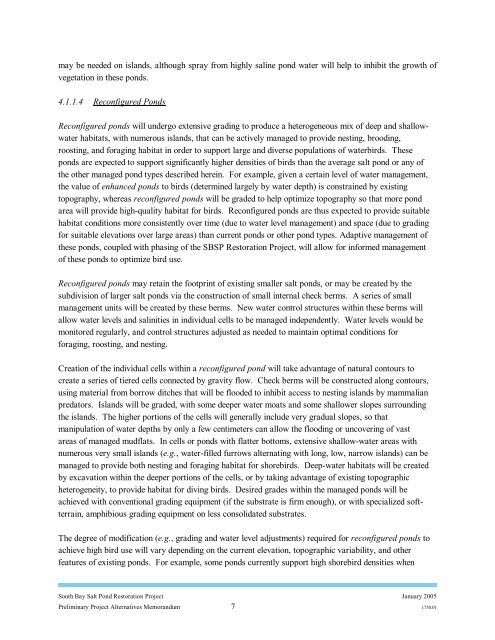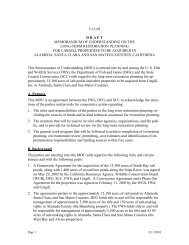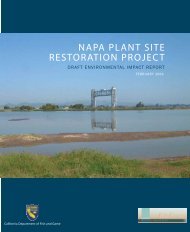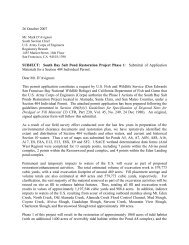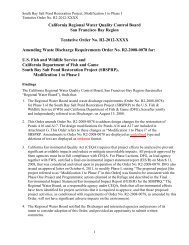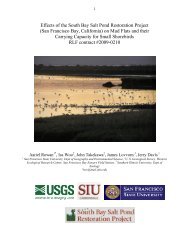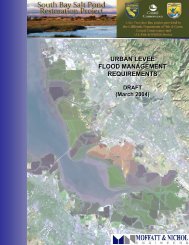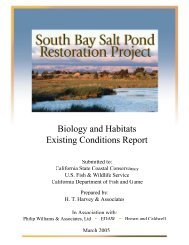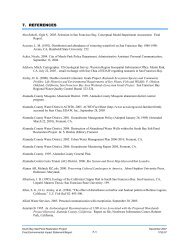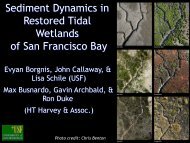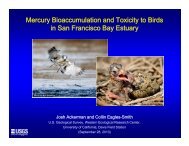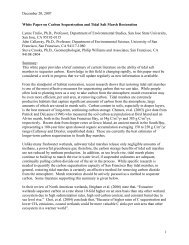M E M O R A N D U M - South Bay Salt Pond Restoration Project
M E M O R A N D U M - South Bay Salt Pond Restoration Project
M E M O R A N D U M - South Bay Salt Pond Restoration Project
You also want an ePaper? Increase the reach of your titles
YUMPU automatically turns print PDFs into web optimized ePapers that Google loves.
may be needed on islands, although spray from highly saline pond water will help to inhibit the growth of<br />
vegetation in these ponds.<br />
4.1.1.4 Reconfigured <strong>Pond</strong>s<br />
Reconfigured ponds will undergo extensive grading to produce a heterogeneous mix of deep and shallowwater<br />
habitats, with numerous islands, that can be actively managed to provide nesting, brooding,<br />
roosting, and foraging habitat in order to support large and diverse populations of waterbirds. These<br />
ponds are expected to support significantly higher densities of birds than the average salt pond or any of<br />
the other managed pond types described herein. For example, given a certain level of water management,<br />
the value of enhanced ponds to birds (determined largely by water depth) is constrained by existing<br />
topography, whereas reconfigured ponds will be graded to help optimize topography so that more pond<br />
area will provide high-quality habitat for birds. Reconfigured ponds are thus expected to provide suitable<br />
habitat conditions more consistently over time (due to water level management) and space (due to grading<br />
for suitable elevations over large areas) than current ponds or other pond types. Adaptive management of<br />
these ponds, coupled with phasing of the SBSP <strong>Restoration</strong> <strong>Project</strong>, will allow for informed management<br />
of these ponds to optimize bird use.<br />
Reconfigured ponds may retain the footprint of existing smaller salt ponds, or may be created by the<br />
subdivision of larger salt ponds via the construction of small internal check berms. A series of small<br />
management units will be created by these berms. New water control structures within these berms will<br />
allow water levels and salinities in individual cells to be managed independently. Water levels would be<br />
monitored regularly, and control structures adjusted as needed to maintain optimal conditions for<br />
foraging, roosting, and nesting.<br />
Creation of the individual cells within a reconfigured pond will take advantage of natural contours to<br />
create a series of tiered cells connected by gravity flow. Check berms will be constructed along contours,<br />
using material from borrow ditches that will be flooded to inhibit access to nesting islands by mammalian<br />
predators. Islands will be graded, with some deeper water moats and some shallower slopes surrounding<br />
the islands. The higher portions of the cells will generally include very gradual slopes, so that<br />
manipulation of water depths by only a few centimeters can allow the flooding or uncovering of vast<br />
areas of managed mudflats. In cells or ponds with flatter bottoms, extensive shallow-water areas with<br />
numerous very small islands (e.g., water-filled furrows alternating with long, low, narrow islands) can be<br />
managed to provide both nesting and foraging habitat for shorebirds. Deep-water habitats will be created<br />
by excavation within the deeper portions of the cells, or by taking advantage of existing topographic<br />
heterogeneity, to provide habitat for diving birds. Desired grades within the managed ponds will be<br />
achieved with conventional grading equipment (if the substrate is firm enough), or with specialized softterrain,<br />
amphibious grading equipment on less consolidated substrates.<br />
The degree of modification (e.g., grading and water level adjustments) required for reconfigured ponds to<br />
achieve high bird use will vary depending on the current elevation, topographic variability, and other<br />
features of existing ponds. For example, some ponds currently support high shorebird densities when<br />
<strong>South</strong> <strong>Bay</strong> <strong>Salt</strong> <strong>Pond</strong> <strong>Restoration</strong> <strong>Project</strong> January 2005<br />
Preliminary <strong>Project</strong> Alternatives Memorandum 7 1750.01


